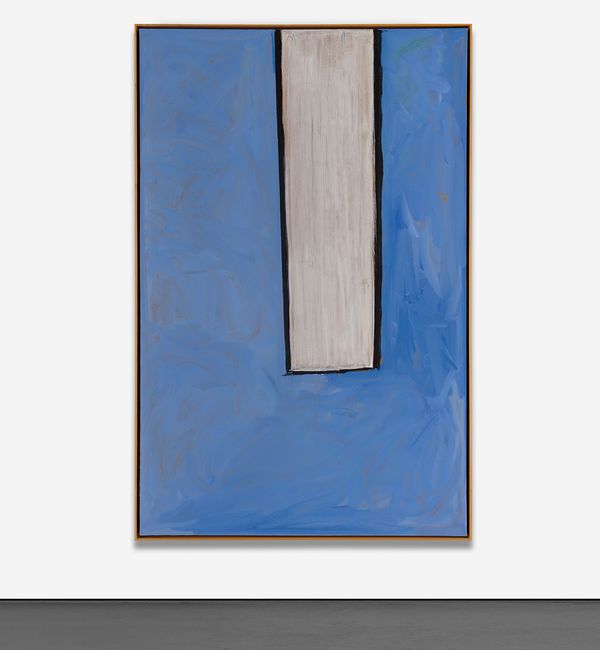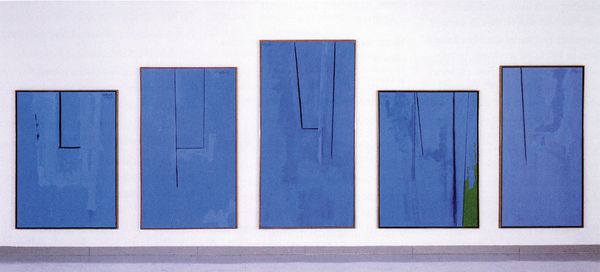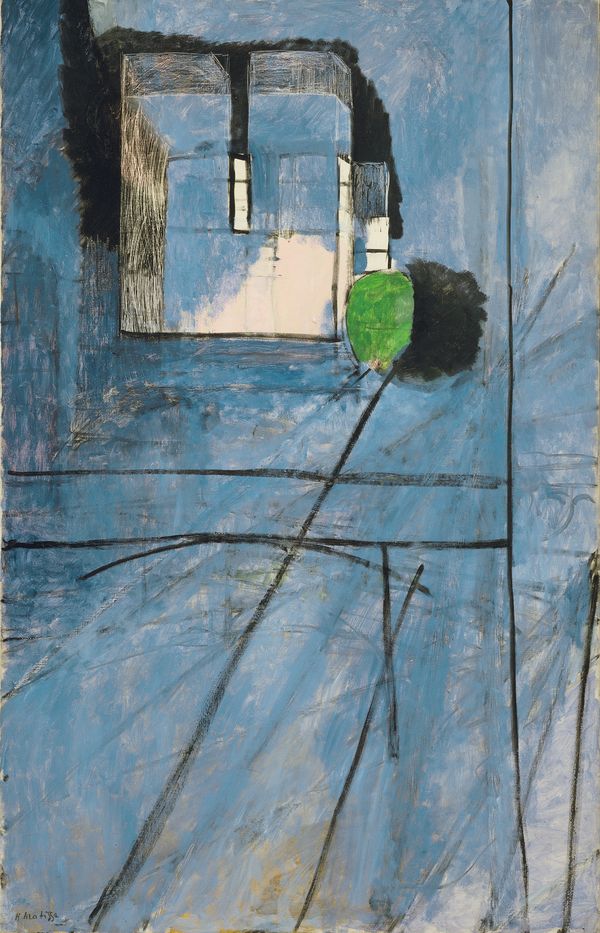Robert Motherwell Open No. 116: La France Open, 1969/1983/circa 1985. Estimate: $1,000,000-1,500,000. Offered on 13 November in the 20th Century & Contemporary Art Day Sale, Morning Session at Phillips New York.
Resplendent in color and gesture, Robert Motherwell’s Open No. 116: La France Open envelops the viewer in an atmospheric blue field of color anchored by a luminous white form outlined in bold black lines. As one approaches the vast surface, hints of green, ultramarine blue, sienna and red begin to reveal themselves behind the veils of pale blue and white paint that Motherwell gesturally applied in subtle, oftentimes semitransparent layers. Completed between 1983 and 1985, this work is the impressive result of over a decade and a half of constant revision. This painting hence simultaneously exhibits elements of his early Opens, as well as the looser, more gestural style that Motherwell pursued in the last decade of his life. An ode to the color blue, Open No. 116: La France Open represents a striking continuation of Motherwell’s celebrated The Blue Painting Lesson paintings from 1973-1975, which reside in the Wadsworth Atheneum Museum of Art, in Hartford.
Robert Motherwell The Blue Painting Lesson: A Study in Painterly Logic, 1973–1975. Wadsworth Atheneum Museum of Art, Hartford, Artwork © 2019 Dedalus Foundation, Inc./Licensed by VAGA at Artists Rights Society (ARS), New York
To encounter Open No. 116: La France Open is to experience an overwhelming sense of contemplation and Zen-like harmony, wholly unique to Motherwell’s Open series. The Opens represented a major shift from the stark black and white of Motherwell’s preceding Elegies, a series begun in the late 1940s. If the Elegies were frequently imbued with undertones of tragedy and suffering, works such as the present example reflect the opposite spectrum of Motherwell’s sensibility.
The Open series was inspired by chance as Motherwell worked in his studio in 1967. Struck by the relationship between a smaller canvas leaning against a larger one, he outlined the smaller canvas in charcoal. According to Motherwell, “The series began as a ‘door’”, which “ultimately reversed into a ‘window’” (Robert Motherwell, “Statement of the Open Series”, 1969, in The Writings of Robert Motherwell). That the first such Open painting was born from a chance episode was not surprising for an artist such as Motherwell, who since his early contact with Surrealism held a firm belief in the generative potential of luck and imagination.
Henri Matisse View of Notre Dame, 1914. The Museum of Modern Art, New York, Digital Image © The Museum of Modern Art/Licensed by SCALA/ Art Resource, NY, Artwork © 2019 Succession H. Matisse/Artists Rights Society (ARS), New York
The Opens also reveal Motherwell’s engagement with the art historical motif of the window, likely prompted by his first in-person encounter with Henri Matisse’s highly abstracted Porte-fenêtre à Collioure, 1914, and the View of Notre Dame, 1914, at The Museum of Modern Art’s 1966 retrospective of the Fauve master. As Jack Flam indeed observed, “The relationship between some of the Opens and Matisse’s View of Notre Dame is striking, in terms of dialogue between drawn line and loosely brushed field of color, and even in the way the exquisite brushstroke in the ground is able to call forth so much luminosity and so much chromatic richness from the blues” (Jack Flam, in, Robert Motherwell Paintings and Collages: A Catalogue Raisonné, 1941 – 1991).
Though many of Motherwell’s Opens have naturalistic points of reference and evoke the image of a window against a wall, the artist emphasized that the motif of the window mainly represented a poetic metaphor to him. Skimming through his copy of the Random House Unabridged Dictionary of the English Language, Motherwell was intrigued by the conceptual breadth and ambiguity of the myriad of definitions for the word “open”. Echoing Stéphane Mallarmé’s belief that a poem should transcend a specific idea or event, Motherwell strove to create open-ended paintings. His paintings are neither meant as direct correspondences to the real world, nor are they exemplary of abstraction as an end in itself.
…each brush stroke is a decision. It is not only a decision of aesthetics – will this look more beautiful? – but a decision that concerns one’s inner I
— Robert Motherwell
Open No. 116: La France Open is a remarkable example of how re-painting formed a core part of Motherwell’s artistic process. The first version of this painting featured a sienna, blue and green composition and as such was titled Open No. 116: In Sienna, Blue and Green when it was consigned to Marlborough-Gerson Gallery in New York. By the time it was exhibited at Knoelder & Company in 1983, however, Motherwell had radically re-painted it – transforming it into a predominantly blue painting with a red Open form and titling it Open No. 116: La France Open. Motherwell then revised it still one more time – painting the rectangular Open form white – to achieve his current composition. This form of constant re-working was a long-standing practice for Motherwell, who once stated, “…each brush stroke is a decision. It is not only a decision of aesthetics – will this look more beautiful? – but a decision that concerns one’s inner I” (Robert Motherwell, quoted in Robert Motherwell, Albright-Knox Art Gallery).
Robert Motherwell’s Open No. 116: La France Open in a previous state in the artist’s studio, circa 1984. Photo by Peter Vitale. Artwork © 2019 Dedalus Foundation, Inc./Licensed by VAGA at Artists Rights Society (ARS), New York
Rather than a matter of perfectionism, this process has been likened to an elusive attempt to find himself through the very act painting. Indeed, as Motherwell declared speaking of his tendency to re-paint works, “I realize that whatever ‘meaning’ that picture has is just the accumulated ‘meaning’ of ten thousand brushstrokes, each one being decided as it was painted. In that sense, to ask what ‘what does this painting mean?’ is essentially unanswerable, except as the accumulation of hundreds of decisions with the brush. On a single day, or during a few hours, I might be in a very particular state, and make something much lighter, much heavier… than I normally would. But when you steadily work at something over a period of time, your whole being must emerge” (Robert Motherwell, quoted in Jack Flam et al., in Robert Motherwell, Albright-Knox Art Gallery).



